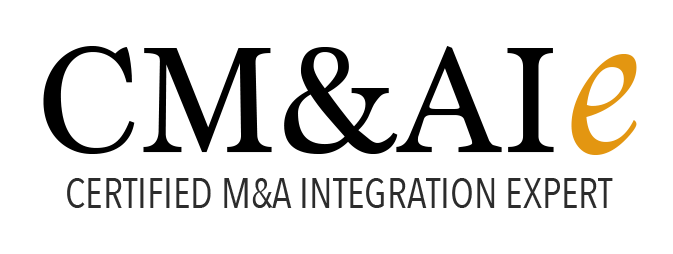Attendees of our M&A Integration Certification Workshop who pass PRITCHETT’s exam (taken online after the workshop) will receive the credential, CM&AIe. The Certified M&A Integration Expert (CM&AIe) designation signifies you have taken the most in-depth available course on merger integration, mastered the content, and developed a core competence in acquisition integration. Verify CM&AIe credentials.
Ten Reasons Why our M&A Certification Training
is Unique and Powerful
- Rock-Solid
Time is money—acquirers must operate fast or fail. Of course, raw speed is not enough to guarantee success. Integrating badly at a high velocity is as big a mistake as moving slowly in hopes of avoiding error.
The secret is to move more rapidly—to accelerate hard—but to have the right touch at the wheel. Speed is an essential element in the right integration approach … it’s just not enough by itself. Our training provides the additional ground rules that position acquirers for success. We cover the concrete principles that collectively are the foundation of our proven, trademarked M&A integration methodology. - Proven
PRITCHETT’s approach has been developed in the trenches on client integrations over the past three decades. Countless merging companies have used our integration process to successfully mobilize their teams across organizations, functions, locations, and cultures. - Efficient
We cut through theoretical bull, popular misconceptions, and wishful thinking on cultural integration. Culture change is arguably the most misunderstood, mismanaged area of M&A. Merging companies frequently waste money and time analyzing cultural differences that are benign and not worthy of investigation.
PRITCHETT’s methodology identifies the few cultural traits that carry enough voltage to impact the bottom line. Our workshop teaches how to zero in on the mission critical variances and make the necessary cultural shifts while also maintaining focus on other integration priorities. - Practical
Our training has no mushy theory. No timewasting trivia. No touchy-feely stuff. We teach participants how to create the deliverables for an integration, who should create them, and when. And we include useful tools and down-to-earth, real-life examples. - Focused
In the name of getting everything done, merging companies often overextend and dilute their resources. Our training teaches participants how to ruthlessly prioritize and scale back the workload so more of what is truly pivotal can be accomplished.
Usually, only a handful of things in an integration will deliver a huge payback. A targeted, sustained focus on these areas, the value drivers, provides the greatest chance of delivering the right outcomes on time, within budget, and without burning people out.
- User-friendly
Integration methodologies advocated by some M&A advisors include complicated rules that create confusion and add no value. In some cases, acquirers feel compelled to hire consultants on an ongoing basis to navigate the very complexity built into the process by the same consultants. An effective methodology should make an organization more self-sufficient, less consultant dependent.
PRITCHETT’s approach is highly teachable. Not over-engineered. A person needs common sense and resolve, not an advanced physics degree, to understand and apply it. - Comprehensive
The yin-yang symbol represents the ancient Chinese understanding of how things work. In the context of merger integration, think of the white area (yang) as the “hard stuff” and the black area (yin) as the “soft stuff.” Yang is project management, yin is people management.
Unlike other integration workshops that take a piecemeal approach, PRITCHETT’s program covers both the yin and yang. Too often, merging organizations concentrate too heavily on one at the expense of the other. Both project and people management require adequate attention in order to realize the full potential of an acquisition.

The Yin-Yang of M&A Integration
- Designed and Delivered by the Thought Leaders
PRITCHETT consultants—the designers and instructors of the workshop—have:
- Consulted on many of the largest, most successful merger integrations in history
- Specialized in post-merger consulting for more than 30 years, longer than any other U.S. firm
- Developed the #1 online resource for merger integration professionals, www.MergerIntegration.com
- Sold our merger and cultural integration books to more than 10,000 merging organizations
- Trained over 30,000 managers in M&A integration, more than any other firm.
- Grounded in Reality
Companies often struggle through integrations because managers have been taught little about the process or, even worse, have been taught the wrong things. many of the correct moves are not obvious. The workshop offers counterintuitive guidelines that you are unlikely to learn anywhere else … except by painful trial and error.
Attendees will learn why acquirers should NOT:- Strive for a “zero defects” merger
- Improve things for improvement’s sake
- Begin the integration with only a high-level plan
- Rely exclusively on a homegrown methodology
- Make “quid pro quo” staffing decisions
- Treat morale as a top priority
- Try to build a common corporate culture
- Ignore lessons learned by other companies
- Provides Valuable Takeaways
-MergerIntegration.com
At the end of the workshop, participants receive a one-year subscription to MergerIntegration.com where they can access videos, playbooks, checklists, PowerPoint presentations, tools, and completed deliverables selected from successful PRITCHETT merger integration consulting and training engagements.
-M&A Integration BooksPRITCHETT consultants have sold over 2 million books on merger and cultural integration, more than all other authors combined. Each attendee will receive these eight titles:- Integration Planning Software
Each participant will receive free online access (for one year) to PRITCHETT's eMerger software ($4,995 value). eMerger is packed with more than 80 integration tools, templates, checklists, matrices, and examples of actual task force deliverables. eMerger helps teams produce work in consistent formats. This consistency facilitates the roll-up of data so more informed, quicker decisions can be made.









